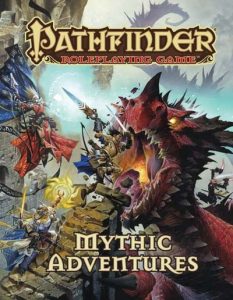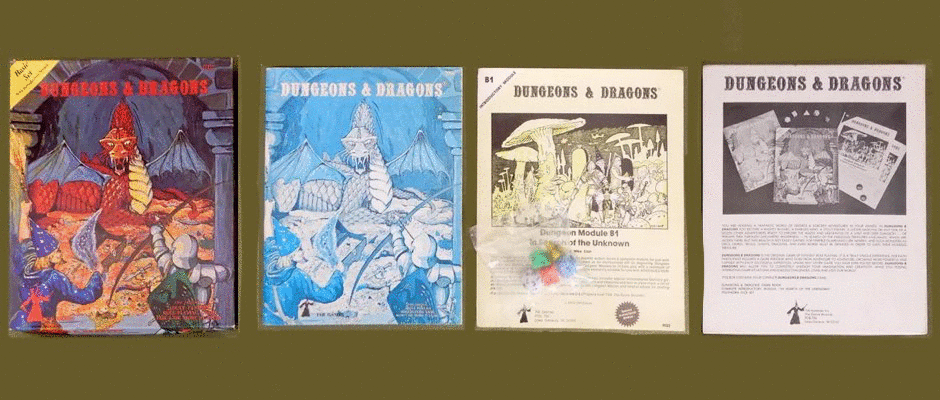
Upon its introduction, I was skeptical and somewhat uninterested in Mythic since I really wanted Pathfinder’s equivalent to WOTC’s old Epic book; it covered characters at 21st and higher levels. Then the podcast my local comic/game store does got me to change my mind when they explained these rules. Mythic elements in Pathfinder aren’t a continuation after PCs/NPCs reach the maximum levels as per the Core Rules, they’re more like accessories to make everything in the game more unique and/or legendary. Mythic power is not gained by experience points neither, the PC (or NPC/Monster) must overcome a Trial. What’s a Trail then? It’s an event, encounter, battle, etc. that requires the heroes/villains to rise way above lesser heroes/villains’ deeds. They serve as the key points in building the legend about the person/creature. As expected, they’re at the GM’s discretion.
The first half is focused on characters/monsters on what Mythic elements do for them. Chapter One is about the Paths. These aren’t necessarily classes, they’re archetypes: archmage, champion, guardian…so they’re applicable to any of the Core‘s 11 classes along with the additional 20+ the Ultimate/Advanced books bring. There’s an option for Universal (or generic) if the player can’t make up their mind. The Paths provide the equivalent of Class abilities and obviously, they’re pretty powerful. A quick example, a Tier One Archmage (originally a Magus, Sorcerer, Witch or Wizard) can take Enduring Armor. With that, the PC automatically has something akin to the spell mage armor operating all the time and it adds three plus the PC’s tier(s) to their AC. The ability can be stopped (albeit briefly) through a dispel spell but the Archmage can re-activate it as a free action (there’s no such thing as swift in my game). Now throw it in with just the basic mythic abilities of hard to kill, surges and mythic powers, you can easily have a nightmare campaign if the GM isn’t careful.
The difference between regular Feats and mythic are their outcomes (Power Attack is +3 per four levels instead of +2); there are occasions when they allow the character to execute a skill as if they rolled a natural 20. The downside to the Feats? Many require the vanilla version as pre-requisites.
Spells follow similar logic as Feats. Mythic alters the results of the standard spell. I’ll pick a favorite, fireball. When the caster chooses the mythic version, they still expend the third-level slot the spell normally uses. The damage increases to d10 instead of the standard d6. Any creature who fails the Reflex saving throw is also on fire at 2d6 per round until it’s put out. I can see myself pursuing this with any arcane-utilizing PC should I ever get to play.
Chapter Four is the most critical, advice on how to run a mythic game. All these power boosts could easily make things boring after a while, right there with playing a video game with all the cheats activated. I appreciated the example Trials too. Designing encounters comes in handy on keeping things challenging.
Magic items in Chapter Five are really way-more expensive items which can do extra-special actions/damage in the hands of mythic wielders. I would also put legendary items we all know from fiction in here: Excalibur, Narsil, Stormbringer and the ring of power from LoTR.
Chapter Six contains common monsters modified with mythic levels and explanations on why or how they gained their mythic levels. Some are the progenitors of their race (the very earliest cyclopses, minotaurs), magic spells (skeletons), they devoured other mythical beings (barghests) or they’re just more important than others (regular mummies guard a mythical mummy who was a king/queen). Again, I would put certain, famous enemies here: Acererak, von Straud/Dracula, Smaug and Eclavdra.
Mythic concludes with an example adventure and additional PC sheet to track mythic progression. The adventure is designed for a quartet of seventh-level PCs without mythic levels. I think they’re handed out at the start or maybe the PCs gain them as they progress. It isn’t very long yet it continues the book’s goal on how mythic is different from an ultra-high-level game.
I really recommend this book to keep in reserve for campaigns when the PCs hit double digits. It has been the inspiration for the primary game I run…when it can happen. I love the idea of a monster that’s more than additional hit points and has a few class levels.
